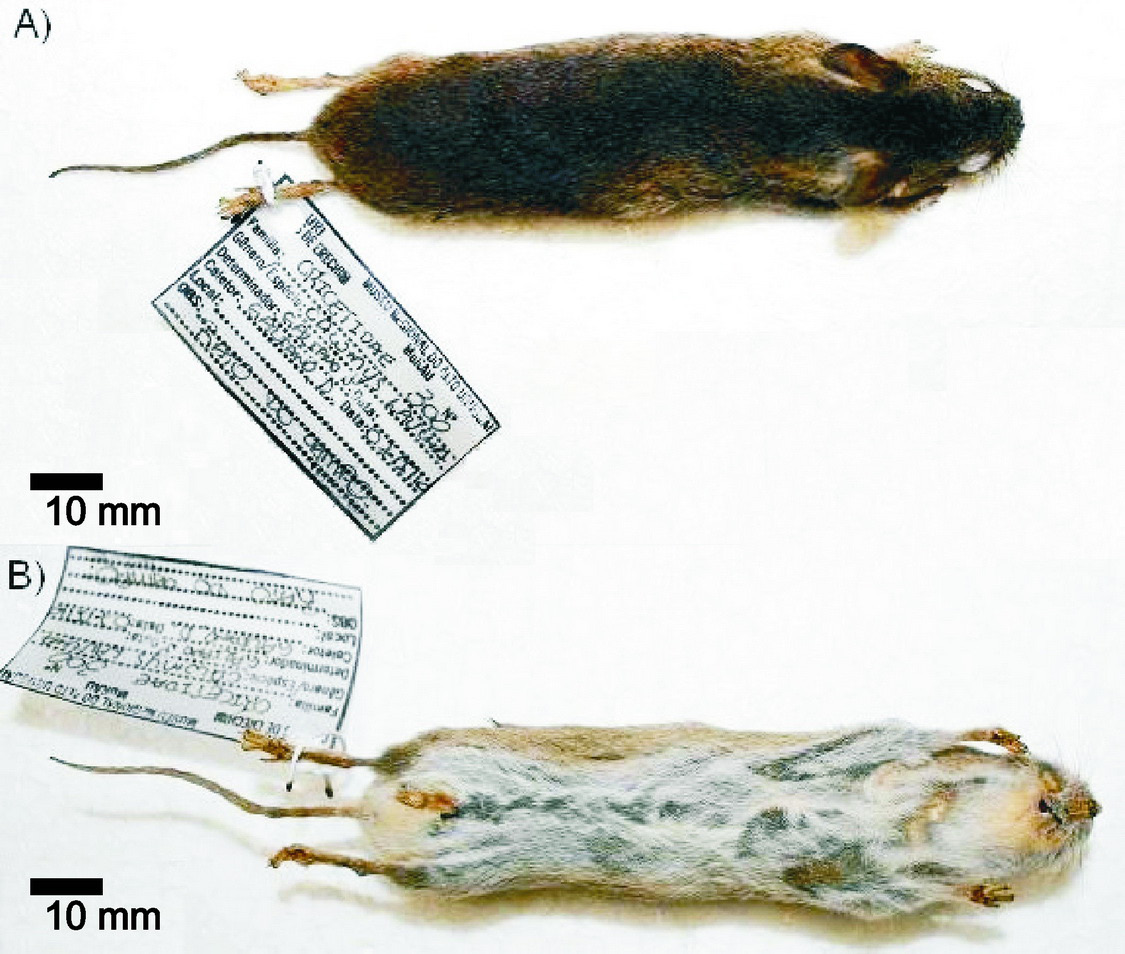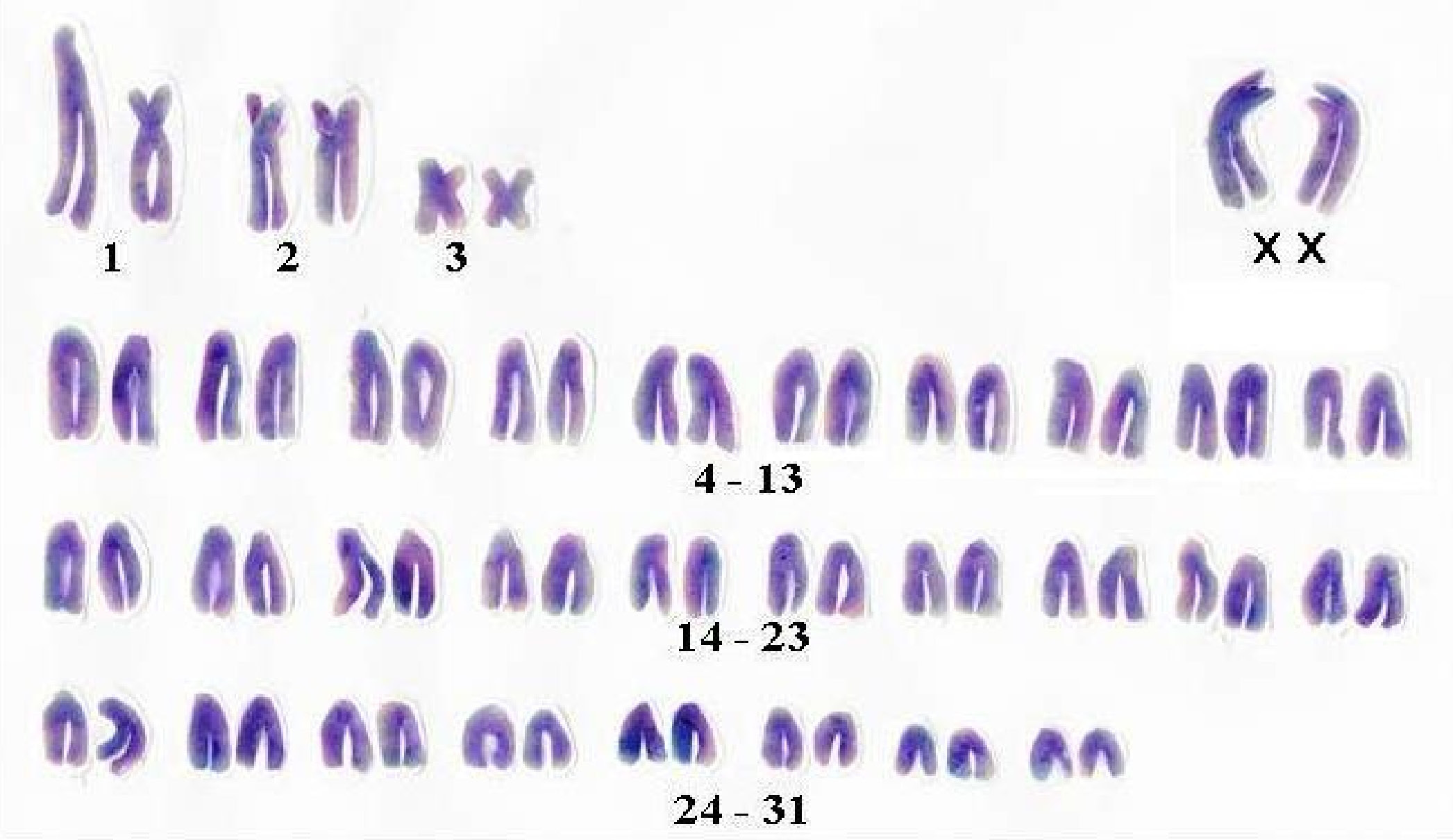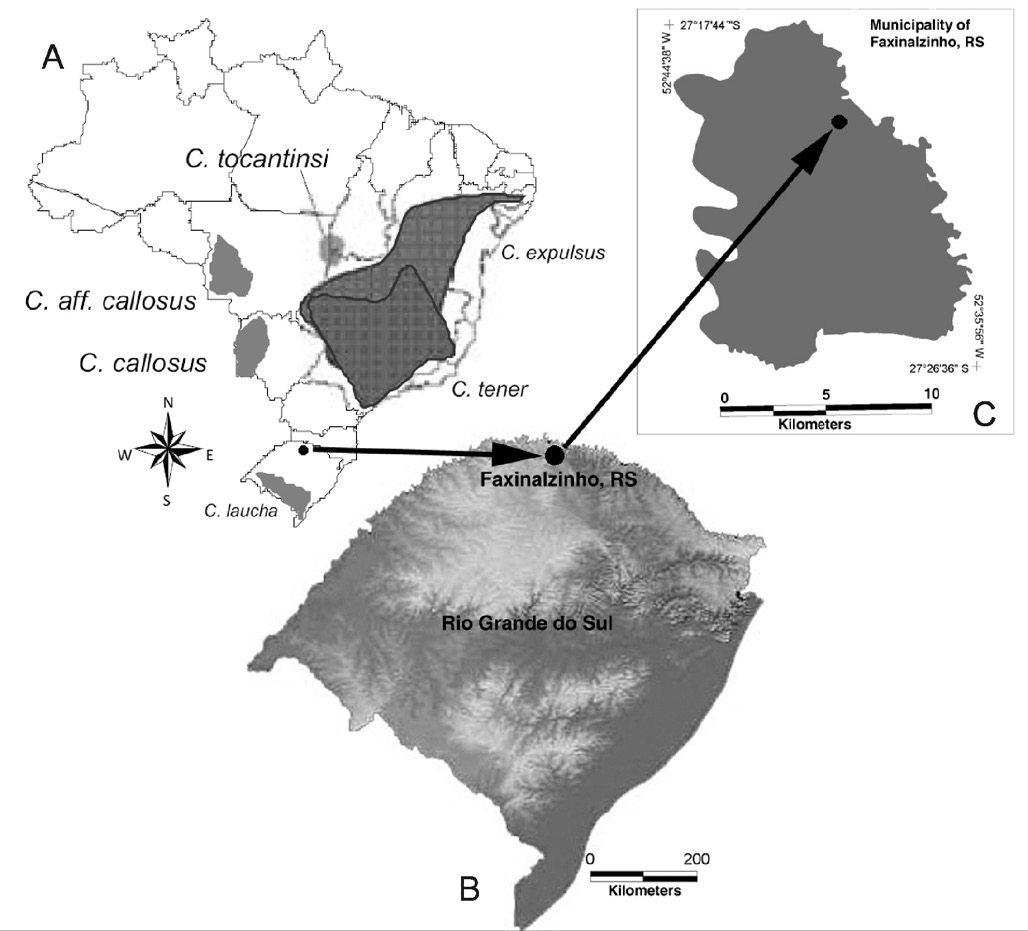Checklist.org.br

Check List 8(2): 264-266, 2012 2012 Check List and Authors
ISSN 1809-127X (available at www.checklist.org.br)
Journal of species lists and distribution
Mammalia, Rodentia, Cricetidae, Calomys laucha (Fischer,
1814): Distribution extension in southern Brazil
Caroline Badzinski 1*, Daniel Galiano 2 and Jorge R. Marinho 1
1 Universidade Regional Integrada do Alto Uruguai e das Missões – Campus de Erechim, Departamento de Ciências Biológicas. Avenida Sete de
Setembro 1621, CEP 99700-000, Erechim, RS, Brasil.
2 Programa de Pós-Graduação em Biologia Animal, Universidade Federal do Rio Grande do Sul, Departamento de Zoologia. Avenida Bento
Gonçalves 9500, prédio 43435, CEP 91501-970, Porto Alegre, RS, Brasil.
* Corresponding author. E-mail: [email protected]
Abstract: The geographic distribution of Calomys laucha in Brazil, known only from the southern portion of Rio Grande
do Sul state, up to the state's Central Depression region, is extended approximately 350 km to the north with a new record
at Faxinalzinho municipality, post Depression region in Rio Grande do Sul state. The species seems to be associated with
dense shrubby vegetation in this area.
Calomys laucha is a small rodent of the subfamily
was sampled on 5 May 2010, in a shrubby area associated
Sigmodontinae (family Cricetidae) that is found only in
with forest borders in the city of Faxinalzinho. The
South America, more specifically in southern Bolivia,
specimen has a body length of 90 mm, tail length of 66
western Paraguay, north and eastern Argentina, Uruguay
mm, ear length of 10 mm, foot length with nails of 16 mm,
and southeastern Brazil (Musser and Carleton 2005;
foot length without nails of 14 mm and weights 16 g. The
Bonvicino et al. 2008). In Brazil, this species is found
individual was captured during a field study developed with
in the Pampas biome in the state of Rio Grande do Sul
the rodent community of that region, which consisted of
(Mattevi et al. 2005). The species has terrestrial habits
three sampling periods between September 2009 and May
and is considered to be mainly granivorous (Vieira and
2010. In each trapping period, traps were placed randomly
Baumgarten, 1995).
on the ground and the total trapping effort amounted to
The conservation status of Calomys laucha has been
2400 trap-nights (800 trap-nights per sampling). Standard
current classified as Least Concern (LC), according to
Tomahawk® traps of one size (12cm x 12cm x 25cm) were
the IUCN Red List of Threatened Species (2011). The
used. Other rodents were concomitantly captured: Akodon
species presents a wide distribution and a presumed large
montensis (36 specimens), Oligoryzomys flavescens (11),
population size (Christoff et al. 2008). This rodent is found
Oligoryzomys nigripes (4), Mus musculus (4) and Akodon
in dry biotopes (González et al. 1995), agricultural areas,
reigi (2). The collection was held under the IBAMA
open vegetation, meadows, mountain ranges, coastal
(Brazilian Institute for the Environment and for Renewable
sandbanks and specimens have been typically recorded in
Natural Resources) permit number: 15224-2.
flat open areas (González 2001; Christoff et al. 2008). In
Argentina, it generally constitutes the dominant species in
cultivated field areas (Polop et al. 1993).
In this paper, we expand the known distribution of
C. laucha to about 350 km north of its range. The new
location is in the city of Faxinalzinho, Rio Grande do Sul,
Brazil (27°20'11.9" S, 52°40'10.9" W), altitude of 685
meters. This new distributional locality is characterized
by a transitional forest between Ombrophilous Mixed
and Seasonal Forests (Leyser et al. 2009). The climate
has marked seasons and is the Cfb type (Köeppen, 1948):
subtropical, with a dominant influence of the territorial
pattern, humid, with rainfall uniformly distributed
throughout the year, and mild summers. The area has
some disturbance caused by cattle that graze in both open
and forested habitats and agricultural activity (soybeans)
which is the predominant activity of the region and occurs
all along the area, which is surrounded by small farming
Figure 1. Adult female of Calomys laucha sampled in Faxinalzinho
municipality, state of Rio Grande do Sul, southern Brazil. Dorsal (A) and
An adult female specimen of Calomys laucha (Figure 1)
ventral (B) views of a stuffed skin (Specimen: Nº Zoo 300).


Badzinski et al. Distribution extension of Calomys laucha in southern Brazil
Figure 2. Conventional karyotype colored with Giemsa obtained from the sampled female of Calomys laucha (2n=64; FNa=68) in the city of Faxinalzinho,
Rio Grande do Sul, southern Brazil.
The specimen identification was done based on
Since only one individual was captured, we can't confirm
external morphological traits (dorsal and lateral pelage
that there is a population established in the area or if it is
coloration, visual identification of a white tufted hair on
an accidental record. This point is crucial since this species
the back of the ear, at the basal part, which is characteristic
is very abundant in the Argentinean agroecosystems
of the genus, and darker color on the upper surface of
and this record could represent an invasive species case
the foot) and confirmed by karyological examination
instead of a natural range extension. Due to the fact that
obtained through the method described by Ford and
there are no major roads nearby which could facilitate
Hamerton (1956) and Guerra and Souza (2002). The
an accidental record (truck driven), we believe that this
individual presented a diploid karyotype number of 2n
new record is a natural range extension, which provides
= 64 and a fundamental number of NFa = 68 (Figure 2),
a significant contribution for the species expansion range.
and was deposited in the Zoological Collection of the
Further studies and surveys in the area may bring some
Museu Regional do Alto Uruguai (MuRAU) at Universidade
answers to this open question.
Regional Integrada do Alto Uruguai e das Missões – URI,
Campus of Erechim (collection number N°Zoo 300). The
same karyotype was found by Mattevi et al. (2005) in the
extreme south of Brazil (near the border with Uruguay,
32° S), which apparently presented the same karyotype
described by Brum-Zorrilla et al. (1990) for individuals of
the surroundings of Laguna Negra, in Uruguay.
Little is known about C. laucha in Brazil and this
new record represents an increase in the geographical
distribution of the species, being the first specimen captured
in the north region of Rio Grande do Sul state, which until
now has presented records only for the southern portion
of this state, in the region of the southern fields (Mattevi et
al. 2005; Bonvicino et al. 2008). This register has expanded
the distributional area of this species in approximately
350 km, officially confirming the presence of the species
above the Central Depression region of the state (Figure
3). According to Christoff et al. (2008), there are no major
threats affecting this species due to its wide distribution
and occurrence in several protected areas. However, it
may present taxonomic problems since a good series of
Figure 3. (A) Geographic distribution of Calomys laucha in Brazil
specimens (including males and females of different age
(Modified From: Bonvicino et al. 2008). (B) Location of the Faxinalzinho
municipality in the state of Rio Grande do Sul. (C) Location of the sampled
classes) has never been collected from a single location.
area in Faxinalzinho municipality, southern Brazil.
Badzinski et al. Distribution extension of Calomys laucha in southern Brazil
Acknowledgments: We thank Mr. Fontana for logistical support and
IUCN 2011. IUCN Red List of Threatened Species. Version 2011.1. Electronic
URI for provide a student fellowship from PIIC/URI to the first author.
Database accessible at http://www.iucnredlist.org/. Captured on 10
Köeppen, W. 1948. Climatologia com un Estudio de los Climas de la Tierra.
Bonvicino, C.R., J.A. Oliveira and P.S. D'andrea. 2008. Guia dos Roedores do
Mexico: Fondo Cultura Económica. 477p.
Brasil, com chaves para gêneros baseadas em caracteres externos. Rio
Leyser, G., M. Viniski, A.L. Donida, M.E. Zanin and J.C Budke, J.C. 2009.
de Janeiro: OPAS/OMS. 120p.
Espectro de dispersão em um fragmento de transição entre floresta
Brum-Zorrilla, N., G.H. Catalfo, C. Degiovanangelo, R.L. Wainberg, and G.
ombrófila mista e floresta estacional na região do Alto Uruguai, Rio
Fronza. 1990. Calomys laucha chromosome (Rodentia, Cricetidae)
Grande do Sul, Brasil. Pesquisas, Botânica 60: 355-366.
from Uruguay and Argentina. Caryologia 43(1): 65-77.
Mattevi, M.S., T. Haag, L.F.B. Oliveira and A.R Langguth. 2005. Chromosome
Christoff, A., M. Weksler, E. Vieira, G. D›Elia, J.P Jayat and U. Pardinas.
characterization of Brazilian species of Calomys Waterhouse,
2008. Calomys laucha. In IUCN 2011. IUCN Red List of Threatened
1837 from Amazon, Cerrado and Pampas domains (Rodentia,
Species. Version 2011.1. Electronic Database accessible at http://
Sigmodontinae). Arquivos do Museu Nacional 63(1): 175-181.
www.iucnredlist.org/. Captured on 10 June 2011.
Musser, G.G. and M.D. Carleton. 2005. Family Muridae; p. 501-755 In
Ford, C.E. and J.L. Hamerton. 1956. A colchicine hypotonic citrate squash
R.E. Wilson and D.M. Reeder (ed.). Mammal Species of the World, A
sequence for mammalian chromosomes. Stain Technology 31(6):
Taxonomic and Geographic Reference, Third Edition. Baltimore: Johns
Hopkins University Press.
Gonzalez, E.M. 2001. Guia de Campo de los Mamiferos de Uraguay.
Polop, J.J. and M.S. Sabattini. 1993. Rodent abundance and distribution
Introduccion al Estudio de los Mamiferos. Montevideo: Vida Silvestre.
in habitats of agrocenosis in Argentina. Studies on Neotropical Fauna
and Environment 28(1): 39-46.
Gonzalez, E.M. and E. Massoia. 1995. Revalidacion del
Vieira, E. M. and L. C. Baumgarten. 1995. Daily activity patterns of small
genero Deltamys Thomas, 1917, con la descripcion de una nueva
mammals in a Cerrado area from central Brazil. Journal of Tropical
subespecie de Uruguay y Sur del Brasil (Mammalia, Rodentia:
Ecology 11(2): 255–262.
Cricetidae). Comunicaciones Zoologicas del Museo de Historia Natural
de Montevideo 12(182): 1-8.
Received: September 2011
Guerra, M. and M.J. Souza. 2002. Como observar cromossomos: um guia
Accepted: February 2012
de técnicas em citogenética vegetal, animal e humana. Ribeirão Preto:
Published online: May 2012
Funpec. 131p.
Editorial responsibility: Ana Paula Carmignotto
Source: http://www.checklist.org.br/getpdf?NGD164-11
UNITED STATES DISTRICT COURT NORTHERN DISTRICT OF ILLINOIS EASTERN DIVISION WENDY DOLIN, Individually and as Independent Executor of the ESTATE OF STEWART DOLIN, deceased, Judge James B. Zagel v. SMITHKINE BEECHAM CORPORATION d/b/a GLAXOSMITHKINE, a Pennsylvania Corporation; and MYLAN INC., a Pennsylvania Corporation, Defendants.
Entfernung spätestens eam 0180/4 09 09 09 eitere Informationen: Mirena® – Kopf frei Mirena®-PassBei der Einlage von Mirena®können Sie sich von IhremFrauenarzt /Ihrer Frauen-ärztin diesen Pass mit Einlege- Mirena® und Entfernungsdatum aus- stellen lassen, damit Sie diese Daten immer präsent haben. Name der Anwenderin Bitte markieren Sie IhreBlutungstage und bringenden Zykluskalender bei



